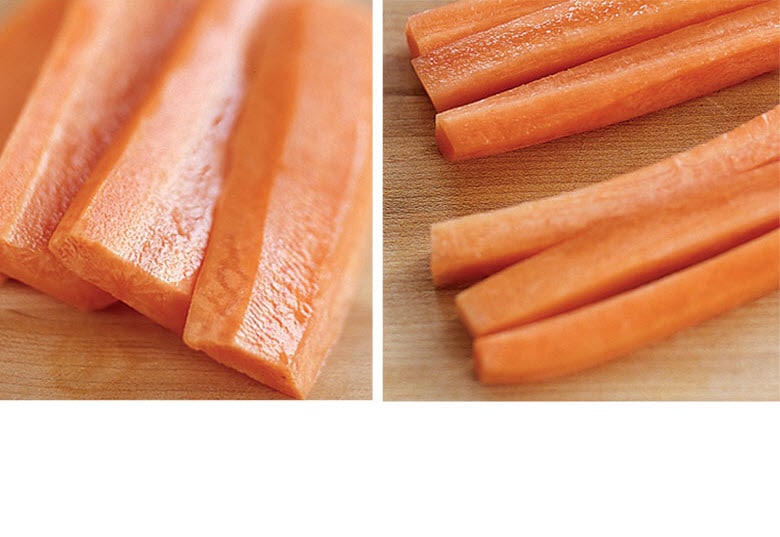
KNIFE SKILLS GUIDE
Know Your Knife

SPINE
The unsharped, top of the blade opposite the cutting edge.
BLADE FACE
The wide, flat part of the
blade that can be used to
crush or transport food.
HANDLE
Where you grip
the knife.
THE BUTT
The farthest
end of the
handle away
from the
blade.
TIP
The point of
the blade
that can be
used for
precision
cutting or
quick slicing.
CUTTING EDGE
The sharp edge of
the knife blade.
BOLSTER
Only in forged
knives, adds
weight and
balances the knife.
TANG
The part of the
blade that extends
into and attaches to
the handle.
Knife Skills Videos
Master These Cuts

1
SLICE
First, create a flat, stable
surface on your vegetable. Using that as
your base, slice to desired thickness
2
MATCHSTICK
Stack 2 or 3 slices at a time, then cut the slices
lengthwise into sticks that are the same width as
the thickness of the slices.

3
DICE
Rotate matchsticks and cut, crosswise,
into evenlysized pieces.
4
JULIENNE
Thinly slice the vegetable, then stack 2 or 3
slices and cut into very thin matchsticks.

5
MINCE
Gather the julienned vegetables into small
bundles, then cut them crosswise into
very small pieces, or mince.
6
ROLL CUT
This is used to give round vegetables more surface area when roasting. Hold the knife on a diagonal and cut, turning ¼ turn between each slice.

7
COARSELY CHOP
Gather the leaves on a cutting board. Rest the
fingertips of one hand on the tip of a chef’s
knife and rock the blade back and forth briefly
over the leaves to coarsely chop them.
8
FINE CHOP
Continue to regather the leaves and rock the
blade over them until they are chopped into
small, even pieces (finely chopped), or into
pieces as fine as possible (minced).
Common Knife Skills Q & A
WHAT'S THE BEST CUTTING BOARD MATERIAL?
The type of cutting surface makes a big difference in the longevity of your knives.
The best cutting surfaces are:

WOOD CUTTING BOARDS
Beautiful and durable, wooden cutting boards
won’t dull blades. Hand-wash, then dry
immediately. Apply mineral oil after each use
so wood doesn’t dry out.
SYNTHETIC CUTTING BOARDS
These include Epicurean wood-composite
cutting boards and polypropylene boards.
Both are gentle on knives, lightweight and
dishwasher safe.
HOW DO I STAY SAFE WHILE SLICING?

Keep knives sharp. An ultra-sharp blade is
much safer, more efficient and easier to use.
Always hold a knife by the handle. If passing
cutlery to another person, lay it down on a
work surface with the handle extended
toward the recipient.
Never immerse knives in a sink full of water.
Never use knives for purposes other than
cutting tasks (e.g., prying open jars and
bottles or scraping the cutting board).
Hand wash knives with warm, soapy water,
then immediately dry and return to storage
for safety. Cutlery should never be cleaned in
the dishwasher.
WHAT'S THE DIFFERENCE BETWEEN
JAPANESE AND GERMAN CUTLERY?

JAPANESE KNIVES
This precision cutlery reflects the samurai
sword-making tradition. Knives have a flatter
cutting edge and no bolster, promoting a
push-pull motion for slicing. Razor-sharp blades
are thinner and more delicate – and typically
ground to a 16-degree angle.
GERMAN KNIVES
These generally have slightly curved cutting
edges and weighted bolsters to facilitate a
rocking motion for chopping and mincing.
German steel is easier to sharpen and is less
likely to chip, but must be honed regularly to
maintain sharpness.
HOW SHOULD I KEEP MY KNIVES SHARP?

There are two ways to maintain your knife's
super-sharp cutting edge: honing and sharpening.
HONING: This shaves the blade to produce a
new, sharp edge.
SHARPENING: A honing steel helps keep a knife
sharp by fine-tuning the edge. Hone knives
before and after each use.
Here are a couple of great tools for sharpening.
MANUAL SHARPENER
Use this compact tool twice a month for
sharpening or touching up straight-edge knives.
ELECTRIC SHARPENER
Use this high-performance sharpener twice a
year to set a razor-sharp edge on any
type of knife.














